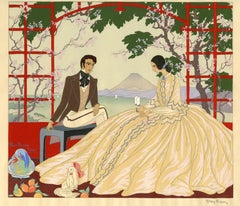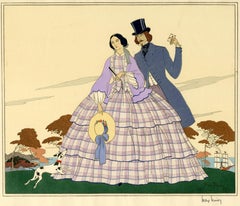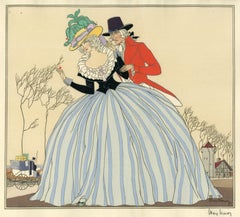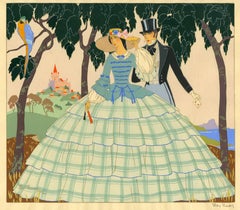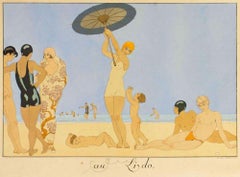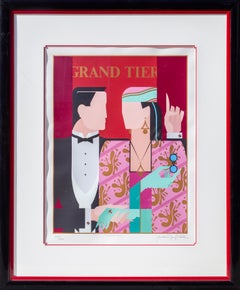Victor Max Ninon Prints and Multiples
to
4
Overall Width
to
Overall Height
to
4
4
1,330
988
773
756
4
4
4
2
2
4
Artist: Victor Max Ninon
Au Japon
By Victor Max Ninon
Located in Fairlawn, OH
Au Japon
Pochoir (Stencil Print), 1925
Signed by the artist in pencil lower right (see photo)
Signed in the image lower left (see photo)
Stamped verso: Made in France
Note: The artis...
Category
1920s Art Deco Victor Max Ninon Prints and Multiples
Materials
Screen
Coquette
By Victor Max Ninon
Located in Fairlawn, OH
Coquette
Pochoir (silk screen) printed in colors, c. 1923-1925
Signed by the artist in pencil lower right; numbered in ink on the image, (see photo)
Edition: 250 (100/250) in pencil in image (see photo)
Image size: 10-1/2 x 12-3/4"
The artist won a gold medal in Paris in 1925 for his porchoirs
Victor Max Ninon (Vittorio Accornero de Testa, Italian, 1896-1982)
Biography
Vittorio Accornero de Testa was born in Casale Monferrato in 1896. He completed his first studies at the "Leardi" institute, but was forced to interrupt them due to the war events of the First World War . At 19 he was second lieutenant of the Alpine troops and in 1916 he took one of the first pilot's licenses. During the war he knows the bitterness of shooting down in air combat (for which he is decorated), but also the good fortune to stay alive, albeit with a disability. His art blossomed in the postwar period, first signing his works simply Ninon and then, probably at the suggestion of a French publisher, under the pseudonym of "Victor Max Ninon" (Victor and Max indicate strength and masculinity, Ninon boyhood) .In 1919 and 1924 he made illustrations for theGiornalino della Domenica , also together with his first wife Edina Altara , for Ardita and La Lettura . In 1923 he won the cover competition organized by the magazine El Hogar of Buenos Aires and in 1925 with his pochoirs he imposed himself in Paris at the international exhibition of modern decorative and industrial arts , obtaining a gold medal. In the same year he made two covers for the US magazine The Smart Set . In the 1920s he made numerous series of art deco style postcards for the Milanese publishing house Degami . On June 4, 1929, aGenoa embarks on the Conte Grande together with his wife Edina Altara , for New York . The two stayed in the American metropolis for a few months: in this period Accornero worked on the creation of theatrical sets and created some covers for Country Life magazine . Accornero gets awards and prizes, but the great economic crisis of the time and the nostalgia for Italy convince the two to return to their homeland, where they resume their activity as illustrators.
In 1934 Accornero moved to Milan, separated amicably from his wife and continued to dedicate himself to the illustration of children's books, abandoning the pseudonym Victor Max Ninon. It illustrates about 60 books, from the fables of Andersen , Perrault and Grimm , to the tales of Poe , as well as the famous Pinocchio and Cuore published by Mondadori, Mursia, Hoepli, Martello. Several books illustrated by Accornero have been published in French, Spanish, German and English. In addition to the periodicals already mentioned, he collaborates on the first edition of the Encyclopedia of Boys , Mondadori, and with the Italian magazines Lidel , Il Secolo XX, The Italian Illustration , Fantasies of Italy , The Woman , Cordelia , For You Lady , Grace , Metropolis , La Domenica del Corriere , The Corriere dei Piccoli .
In 1936 enters the world of cinema, creating sets and costumes for Wedding Vagabonde of Guido Brignone and The White Squadron of Augustus Genina . From 1935 to 1950 he also devoted himself to the theater, taking care of sets and costumes for numerous operettas, ballets and performances at the Scala in Milan and for the Milanese theaters Manzoni, Lirico and Olympia. Stages Marcello di Giordano, Nina pazza d'amore by Paisiello, I cantori di Nurimberga by Wagner, La Bohème by Puccini and other works. For this activity he is also cited in the Theater encyclopedia.
In the 1940s and 1950s he wrote and illustrated six books for children for Mondadori: Tomaso (1944), Giacomino (1949), Tomaso Cacciatore (1950), Zio Stefano (1950), In Campagna che delizia! (1953), Tomaso, dear Tomaso (1955). His illustrations of Perrault's Tales published in those years by Hoepli are famous.
His art in the fifties evolves towards hyperrealism . There are many personal exhibitions in Italy and abroad, including those at the Gallerie Gussoni (1959) and Bolzani (1963 and 1966) in Milan and Walcheturm (1962) in Zurich. Eminent critics praise his work, from Orio Vergani to Enrico Piceni, from Reto Roedel to De Chirico himself. On the Domenica del Corriere , the journalist, writer and painter Dino Buzzati...
Category
1920s Art Deco Victor Max Ninon Prints and Multiples
Materials
Stencil
Robe Grise
By Victor Max Ninon
Located in Fairlawn, OH
Robe Grise
Pochoir (silk screen) printed in colors, 1923
Signed by the artist in pencil lower right (see photo)
The artist won a gold medal in Paris in 1925 for his pochoirs
Condition: Two spots in the upper left corner associated with the printing.
Victor Max Ninon (Vittorio Accornero de Testa, Italian, 1896-1982)
Biography
Vittorio Accornero de Testa was born in Casale Monferrato in 1896. He completed his first studies at the "Leardi" institute, but was forced to interrupt them due to the war events of the First World War . At 19 he was second lieutenant of the Alpine troops and in 1916 he took one of the first pilot's licenses. During the war he knows the bitterness of shooting down in air combat (for which he is decorated), but also the good fortune to stay alive, albeit with a disability. His art blossomed in the postwar period, first signing his works simply Ninon and then, probably at the suggestion of a French publisher, under the pseudonym of "Victor Max Ninon" (Victor and Max indicate strength and masculinity, Ninon boyhood) .In 1919 and 1924 he made illustrations for theGiornalino della Domenica , also together with his first wife Edina Altara , for Ardita and La Lettura . In 1923 he won the cover competition organized by the magazine El Hogar of Buenos Aires and in 1925 with his pochoirs he imposed himself in Paris at the international exhibition of modern decorative and industrial arts , obtaining a gold medal. In the same year he made two covers for the US magazine The Smart Set . In the 1920s he made numerous series of art deco style postcards for the Milanese publishing house Degami . On June 4, 1929, aGenoa embarks on the Conte Grande together with his wife Edina Altara , for New York . The two stayed in the American metropolis for a few months: in this period Accornero worked on the creation of theatrical sets and created some covers for Country Life magazine . Accornero gets awards and prizes, but the great economic crisis of the time and the nostalgia for Italy convince the two to return to their homeland, where they resume their activity as illustrators.
In 1934 Accornero moved to Milan, separated amicably from his wife and continued to dedicate himself to the illustration of children's books, abandoning the pseudonym Victor Max Ninon. It illustrates about 60 books, from the fables of Andersen , Perrault and Grimm , to the tales of Poe , as well as the famous Pinocchio and Cuore published by Mondadori, Mursia, Hoepli, Martello. Several books illustrated by Accornero have been published in French, Spanish, German and English. In addition to the periodicals already mentioned, he collaborates on the first edition of the Encyclopedia of Boys , Mondadori, and with the Italian magazines Lidel , Il Secolo XX, The Italian Illustration , Fantasies of Italy , The Woman , Cordelia , For You Lady , Grace , Metropolis , La Domenica del Corriere , The Corriere dei Piccoli .
In 1936 enters the world of cinema, creating sets and costumes for Wedding Vagabonde of Guido Brignone and The White Squadron of Augustus Genina . From 1935 to 1950 he also devoted himself to the theater, taking care of sets and costumes for numerous operettas, ballets and performances at the Scala in Milan and for the Milanese theaters Manzoni, Lirico and Olympia. Stages Marcello di Giordano, Nina pazza d'amore by Paisiello, I cantori di Nurimberga by Wagner, La Bohème by Puccini and other works. For this activity he is also cited in the Theater encyclopedia.
In the 1940s and 1950s he wrote and illustrated six books for children for Mondadori: Tomaso (1944), Giacomino (1949), Tomaso Cacciatore (1950), Zio Stefano (1950), In Campagna che delizia! (1953), Tomaso, dear Tomaso (1955). His illustrations of Perrault's Tales published in those years by Hoepli are famous.
His art in the fifties evolves towards hyperrealism . There are many personal exhibitions in Italy and abroad, including those at the Gallerie Gussoni (1959) and Bolzani (1963 and 1966) in Milan and Walcheturm (1962) in Zurich. Eminent critics praise his work, from Orio Vergani to Enrico Piceni, from Reto Roedel to De Chirico himself. On the Domenica del Corriere , the journalist, writer and painter Dino...
Category
1920s Art Deco Victor Max Ninon Prints and Multiples
Materials
Stencil
En Espagne
By Victor Max Ninon
Located in Fairlawn, OH
En Espagne
Pochoir (silk screen) printed in colors
Signed by the artist in pencil lower right
The artist won a gold medal in Paris in 1925 for his pochoirs
Condition: Excellent
Image...
Category
1920s Art Deco Victor Max Ninon Prints and Multiples
Materials
Screen
Related Items
Au Lido - Pochoir by G. Barbier - 1920
By George Barbier
Located in Roma, IT
This pochoir belongs to the portfolio 'Le Bonheur du Jour', by George Barbier.
A very fine work of one of the most important and famous european illustrators of Art Deco, whose infl...
Category
1920s Art Deco Victor Max Ninon Prints and Multiples
Materials
Stencil
Grand Tier, Art Deco Screenprint by Giancarlo Impiglia
By Giancarlo Impiglia
Located in Long Island City, NY
Artist: Giancarlo Impiglia, Italian/American (1940 - )
Title: Grand Tier
Year: 1984
Medium: Screeenprint, signed and numbered in pencil
Edition: 205/250
Image Size: 25 x 19.5 inches
...
Category
1980s Art Deco Victor Max Ninon Prints and Multiples
Materials
Screen
Loves Passenger, Art Deco Screen Print by Muramasa Kudo
By Muramasa Kudo
Located in Long Island City, NY
Muramasa Kudo, Japanese (1948 - ) - Loves Passenger, Medium: Screenprint, signed and numbered in pencil, Edition: 150/275, Image Size: 26.5 x 35.75 inches, Size: 33 x 41.75 in. (83.8...
Category
Late 20th Century Art Deco Victor Max Ninon Prints and Multiples
Materials
Screen
CAPRICORN
By Erté
Located in Aventura, FL
Hand signed and numbered by the artist. From the Zodiac Suite. Framed size approx 31 x 26 inches. Artwork in excellent condition. Additional images are available upon request. Certif...
Category
1980s Art Deco Victor Max Ninon Prints and Multiples
Materials
Screen, Paper
L'apres-midi d'un Faune - Pochoir by G. Barbier - 1920
By George Barbier
Located in Roma, IT
This is one of the artworks in the portfolio 'Le Bonheur du Jour', by George Barbier.
A very fine work of one of the most important and famous european illustrators of Art Deco, who...
Category
1920s Art Deco Victor Max Ninon Prints and Multiples
Materials
Stencil
H 12.6 in W 17.72 in D 0.04 in
California (Turquoise Dress), 1989
By Erte - Romain de Tirtoff
Located in Greenwich, CT
California (Turquoise Dress) is an expertly crafted, embossed serigraph on black paper with foil stamping and an image size of 33 x 25.5 inches. From the edition of 668, the art is n...
Category
20th Century Art Deco Victor Max Ninon Prints and Multiples
Materials
Paper, Screen
Lyre, 1990
By Erté
Located in Greenwich, CT
Lyre is an expertly crafted, embossed serigraph on black paper with foil stamping and an image size of 28.5 x 23.5 inches. From the edition of 650, the art is numbered 161/300 and es...
Category
20th Century Art Deco Victor Max Ninon Prints and Multiples
Materials
Paper, Screen
Florida (Pearl Dress)
By Erte - Romain de Tirtoff
Located in Greenwich, CT
Florida (Pearl Dress) is an expertly crafted, embossed serigraph on black paper with foil stamping and an image size of 33 x 25.5 inches. From the edition of 686, the art is numbered 212/300 and signed 'Erté' lower right (there were also 300 Roman, 65 AP, 1 PP and 20 HC). framed in an elegant gold-tone moulding.
Originally a costume design for the American Millionairess Revue at the Théâtre Fémina in Paris in 1917, Florida (Pearl Dress) stands as a testament to the genius and creativity of Erté. It was at the Théâtre Fémina that Erté worked closely with Gaby Deslys, the greatest French music-hall star of her day. It was Madame Rasimi – the theater’s founder – wo discovered the young Romain de Tirtoff (Erté) and employed his talents to her theater’s great benefit.
In Pearl Dress, the flowing gold train cascades from the gown to create a wonderful sense of style and grace. As the primary source of color in the design, the gold and pearls sit in contrast to the dynamic black background of the print, while the geometric pattern of rectangles and squares, all deeply embossed and metal-foiled, create the perception of depth and drama.
One of the earliest costume designs by Erté, Pearl Dress stood as a reflection of American culture – of riches and excess – while expressing Erté’s love...
Category
20th Century Art Deco Victor Max Ninon Prints and Multiples
Materials
Paper, Screen
pochoir
By (after) Auguste Rodin
Located in Henderson, NV
Medium: pochoir (after the watercolor). Printed in 1944 at the Rene Kieffer atelier and published by Rombaldi in an edition of 300 for the rare "La Varende" portfolio. Size: 13 1/4 x...
Category
1940s Victor Max Ninon Prints and Multiples
Materials
Lithograph, Stencil
L'Ete (Summer), Pochoir by Joan Miro 1938
By Joan Miró
Located in Long Island City, NY
Artist: Joan Miro, Spanish (1893 - 1983)
Title: L'Ete (Summer) from Verve (Vol. 1, No. 3)
Year: 1938
Medium: Color Pochoir on Wove Paper, signed, titled and dated in the plate, verso...
Category
1930s Surrealist Victor Max Ninon Prints and Multiples
Materials
Stencil
Art Deco 1925 Signed Limited Edition Screen Print
By Michael Knigin
Located in Rochester Hills, MI
Art Deco 1925
1980
Silkscreen
Paper size 33½" × 21"inches
Signed in pencil and marked 234/300
Michael Knigin was born in 1942 in Brooklyn, NY. He attended and graduated from Tyler S...
Category
1980s Art Deco Victor Max Ninon Prints and Multiples
Materials
Screen
Fedora Fur, 1990
By Erte - Romain de Tirtoff
Located in Greenwich, CT
Fedora Fur is an expertly crafted, embossed serigraph on paper with foil stamping and an image size of 34 x 26 inches. From the edition of 650, the art is numbered 98/300 and estate-stamped 'Erté' lower right (there were also 300 Roman, and 50 AP). Framed in an elegant, gold-tone moulding.
This image was inspired by a design that Erté created for Ganna Walska...
Category
20th Century Art Deco Victor Max Ninon Prints and Multiples
Materials
Paper, Screen
Victor Max Ninon prints and multiples for sale on 1stDibs.
Find a wide variety of authentic Victor Max Ninon prints and multiples available for sale on 1stDibs. You can also browse by medium to find art by Victor Max Ninon in screen print, stencil and more. Much of the original work by this artist or collective was created during the 1920s and is mostly associated with the Art Deco style. Not every interior allows for large Victor Max Ninon prints and multiples, so small editions measuring 13 inches across are available. Customers who are interested in this artist might also find the work of Paul Vera, Umberto Brunelleschi, and Charles Turzak. Victor Max Ninon prints and multiples prices can differ depending upon medium, time period and other attributes. On 1stDibs, the price for these items starts at $550 and tops out at $800, while the average work can sell for $650.
